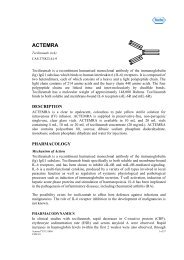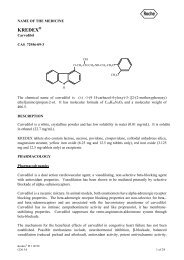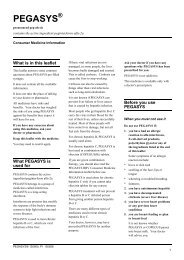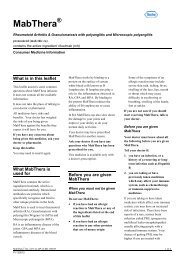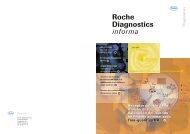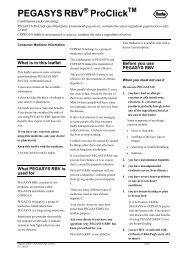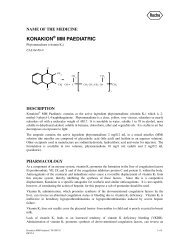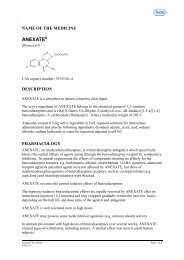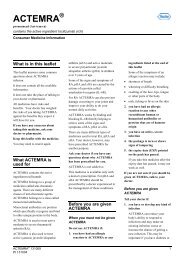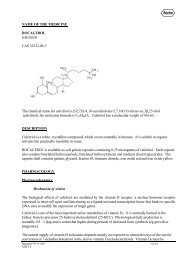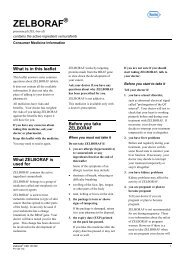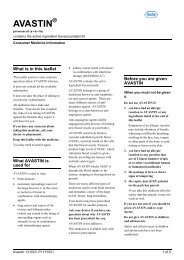Product Information PI - Roche Australia
Product Information PI - Roche Australia
Product Information PI - Roche Australia
You also want an ePaper? Increase the reach of your titles
YUMPU automatically turns print PDFs into web optimized ePapers that Google loves.
The ADRs that occurred in ≥ 1% of children aged 1 – 12 years receiving TAMIFLU in the<br />
clinical trials for treatment of naturally acquired influenza (n = 858), and whose incidence is<br />
at least 1% higher on TAMIFLU compared to placebo (n = 622), is vomiting (16% on<br />
oseltamivir vs. 8% on placebo). Amongst the 148 children who received the recommended<br />
dose of TAMIFLU once daily in a post-exposure prophylaxis study in households (n = 99),<br />
and in a separate 6-week paediatric prophylaxis study (n = 49), vomiting was the most<br />
frequent ADR (8% on TAMIFLU vs. 2% in the no prophylaxis group). TAMIFLU was well<br />
tolerated in these studies and the adverse events noted were consistent with those previously<br />
observed in paediatric treatment studies.<br />
Adverse events reported in ≥ 1% of the children taking TAMIFLU in the treatment studies (n<br />
= 858) or ≥ 5% of the children in the prophylaxis studies (n = 148), which occurred more<br />
frequently in the children on placebo/no prophylaxis or where the difference between the<br />
oseltamivir and placebo/no prophylaxis arm was < 1%, were the following:<br />
Gastrointestinal Disorders (TAMIFLU versus placebo)<br />
- Treatment: diarrhoea (9% vs. 9%), nausea (4% vs. 4%), abdominal pain (incl. upper<br />
abdominal pain, 3% vs. 3%)<br />
Infections and Infestations (TAMIFLU vs. placebo)<br />
- Treatment: otitis media (5% vs. 8%), bronchitis (2% vs. 3%), pneumonia (1% vs.<br />
3%), sinusitis (1% vs. 2%)<br />
Respiratory, Thoracic and Mediastinal Disorders (TAMIFLU vs. placebo)<br />
- Treatment: asthma (including aggravated asthma, 3% vs. 4%), epistaxis (2% vs. 2%)<br />
- Prophylaxis: cough (12% vs. 26%), nasal congestion (11% vs. 20%)<br />
Skin and Subcutaneous Tissue Disorders (TAMIFLU vs. placebo)<br />
- Treatment: dermatitis (including allergic and atopic dermatitis, 1% vs. 2%)<br />
Disorders of Ear and Labyrinth (TAMIFLU vs. placebo)<br />
- Treatment: earache (1% vs. < 1%)<br />
Disorders of the Eye (TAMIFLU vs. placebo)<br />
- Treatment: conjunctivitis (including red eyes, eye discharge and eye pain, 1% vs.<br />
< 1%)<br />
Additional adverse events reported from paediatric treatment studies, which previously<br />
qualified to be presented above, however in larger datasets did not fulfill the criteria for<br />
inclusion in previous sections anymore, are given below:<br />
Disorders of Blood and Lymphatic system (TAMIFLU vs. placebo)<br />
- Treatment: lymphadenopathy (< 1% vs. 1%)<br />
Disorders of Ear and Labyrinth (TAMIFLU vs. placebo)<br />
- Treatment: tympanic membrane disorder (< 1% vs. 1%)<br />
Post-Marketing Experience<br />
The following adverse events have been identified during post-marketing use of TAMIFLU.<br />
Because these events are reported voluntarily from a population of uncertain size, it is not<br />
possible to reliably estimate their frequency and/or establish a causal relationship to<br />
TAMIFLU exposure.<br />
Tamiflu <strong>PI</strong> 6 mg/mL oral suspension and capsules 120119 18 of 28<br />
CDS 10.0



